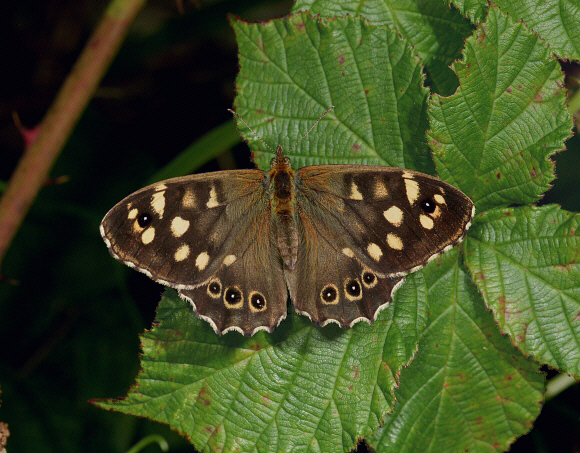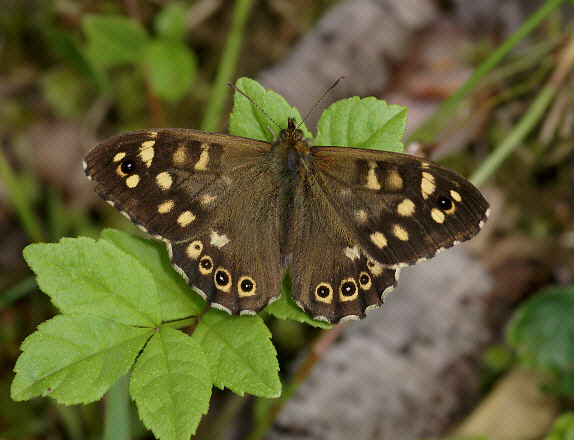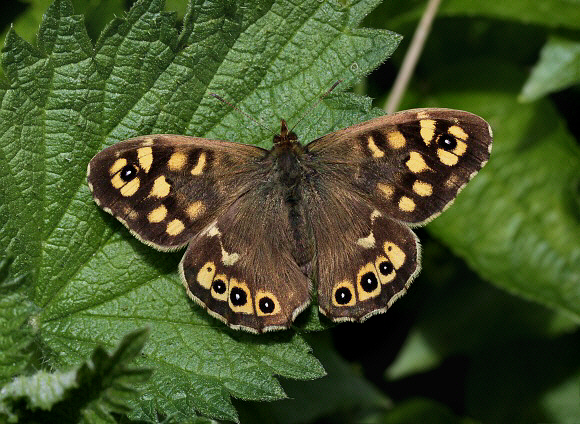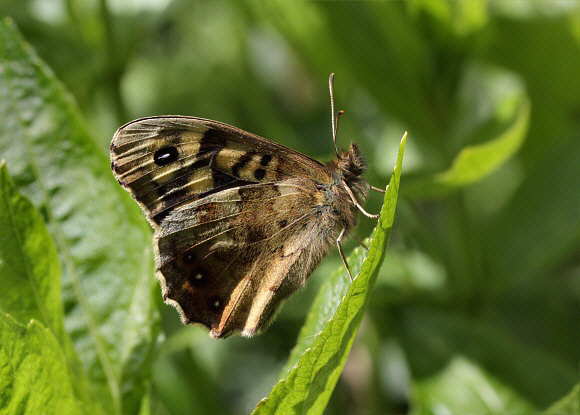 Speckled Wood Pararge aegeria, female – Adrian Hoskins
Speckled Wood Pararge aegeria, female – Adrian Hoskins
Introduction
This common woodland butterfly was originally known in Britain as the Enfield Eye or Wood Argus. The name Speckled Wood first appeared in 1766, in Moses Harris’s famous book The Aurelian.
The butterfly is widely distributed in Europe but is absent from the sub-arctic areas of Norway and Sweden. Beyond Europe it occurs in the Atlas mountains of north Africa and extends into Asia as far east as the central Ural mountains.
The British / northern European subspecies tircis is marked with pale creamy spots, but in southern Europe the normal form of the butterfly has the wings patterned with large orange blotches, and can be mistaken for the Wall Brown Lasiommata megera.
There are 2 other similar Pararge species – xiphiopides which is endemic to the Canary Islands, and xiphia which is endemic to Madeira ( where aegeria also occurs ).
 Speckled Wood, male, Pararge aegeria, Powerstock Common, Dorset – Adrian Hoskins
Speckled Wood, male, Pararge aegeria, Powerstock Common, Dorset – Adrian Hoskins
Habitats
It is often stated that butterflies make excellent “indicator” species, as their distribution ranges and population dynamics adjust rapidly in response to changes in the environment. This is particularly true of the Speckled Wood. The butterfly was widespread and fairly common in Britain until the late 19th century when it suffered a sudden and unexplained collapse in numbers. Then from the 1930’s onwards it gradually expanded it’s range : this species favours darker and damper woodlands than most other butterfly species, so it’s populations expanded in response to the large scale conversion of coppiced woodlands to plantation management.
Today the Speckled Wood is regarded as a common woodland butterfly which breeds in damp areas where dappled sunlight filters through the trees. It can commonly be seen basking on low foliage or on forest paths in deciduous woodland. It is quite tolerant of shade and can also be found in conifer plantations, where it breeds along grassy rides.
In recent years it has shown a favourable response to climatic change, having expanded into more open habitats, and can regularly be seen in gardens, along hedgerows, and scrubby areas of open grassland. It has also extended it’s range northwards, now reaching Ullapool in n.w. Scotland.
 Speckled Wood, male, Pararge aegeria, Leicester – Adrian Hoskins
Speckled Wood, male, Pararge aegeria, Leicester – Adrian Hoskins
Lifecycle
The Speckled Wood is unique among British species in that it can hibernate as either a caterpillar or chrysalis. Thomas states that “…caterpillars which experience 12 or more hours of light a day go on to form adults the same year, whereas those that receive less light either form hibernating pupae, or overwinter as caterpillars”. The consequence of this dual overwintering strategy is that the spring emergence of adults is very protracted.
There is some disagreement about how many broods occur in various parts of Britain. It certainly produces 3 broods most years in southern England. In Scotland the 3rd brood is partial.
Normally the adults begin to appear in late March or early April but the emergence extends well into June, overlapping with the second brood which flies between late June and August. The third brood begins in August at some sites, but not until September at others, where late emerging adults may still be flying in early November. Individuals have a lifespan of between about 7-20 days.
The egg is spherical, straw coloured, and finely ribbed. Sometimes the eggs are dropped randomly among grasses while the butterfly is in flight, but equally often the females settle and glue the eggs singly to the underside of grass blades. Oviposition always occurs where the grasses are growing in dappled light, usually around the base of bushes or sapling trees.
The caterpillar hatches after about a week. Most other Satyrine larvae are crepuscular but the larva of the Speckled Wood feeds by daylight. It is pale green, marked with thin longitudinal pale yellow and whitish stripes, and is perfectly camouflaged at rest on grass blades. It feeds on soft grasses, principally cocksfoot Dactylis glomerata, couch Agropyron repens, creeping soft grass Holcus mollis, Yorkshire-fog Holcus lanatus, wood millet Milium effusum and wood meadow grass Poa nemoralis.
The chrysalis is formed hanging by the cremaster from woody stems. It is variable in colour, some being pale green, while others can be quite dark, particularly those of the over-wintering brood.
 Speckled Wood Pararge aegeria, male, Evington meadow, Leicestershire – Adrian Hoskins
Speckled Wood Pararge aegeria, male, Evington meadow, Leicestershire – Adrian Hoskins
Adult behaviour
The Speckled Wood flies in shadier habitats than most other British butterflies, and is commonly active on dull overcast days when other species refuse to fly.

Speckled Wood Pararge aegeria, Evington meadow, Leicestershire – Adrian Hoskins
On sunny mornings the males take up residence in areas of woodland where dappled sunlight filters through the trees. Each male selects a “perch” in the form of a sunlit leaf, from which it can survey and intercept passing females. During the course of the morning, the changing position of the sun causes the various perching places to be periodically shaded, at which time each male has to move to establish a new perch. Inevitably this results in a high number of male-male encounters.
When males meet, they engage in a sortie, spiralling up to the tree tops. This appears to be a test of strength, but probably also involves chemical messages. After each sortie a “winner” emerges to return to his chosen perch. Experiments have shown that the winning male is usually the one which first established his perch. The intruding male is ousted and has to establish a new perch elsewhere in the vicinity. In experiments when 2 males have been introduced simultaneously into an area, and both believe they have ownership of a perch, the ensuing sortie can continue unabated for several minutes. Ultimately one of the combatants seems to get lost or gets distracted, leaving the other to reclaim its perch.
Some males adopt a different mate-location strategy, choosing to patrol in search of females. In his fascinating book Butterflies of Britain and Ireland, Jeremy Thomas states that “certain individuals – especially those possessing 4 spots on the upperside of each hindwing, are more inclined to perch, whereas males with 3 spots have a tendency to patrol”.
Males always intercept other Speckled Woods of either sex but usually ignore other species. When a receptive female is intercepted, she settles on foliage, and spreads her wings. The male then settles below her, and gently walks onto her hindwings. Butterflies have olfactory sensors on their feet, so this ritualised behaviour enables the male to taste her chemical scent and determine whether she is recently emerged – vital information because younger females have a longer life ahead of them and are therefore capable of laying more eggs.
The adult butterflies feed primarily on aphid secretions on the upper surface of oak, ash or hazel leaves. The spring generation rarely visit flowers, although I have at times seen them nectaring at wood spurge. Summer brood males sometimes nectar at fleabane or knapweed flowers, but are more often seen feeding at the juices oozing from fermenting blackberries. Females prefer to feed on the sticky secretion which coats ash buds. I have often seen individuals spend several minutes at a time walking about on ash twigs, avidly feeding on the sticky secretion which coats the buds. I have also observed them nectaring at the blossom of trees and bushes including pear, hawthorn, lime and buckthorn.
Overnight and in dull, cold or wet weather the butterflies roost in bushes – e.g. at Ballard Down in Dorset they commonly roost in prickly gorse bushes, at Stansted Forest in West Sussex they roost in bramble bushes, and at Noar Hill in Hampshire I have seen them enter blackthorn and dogwood bushes in late afternoon.
